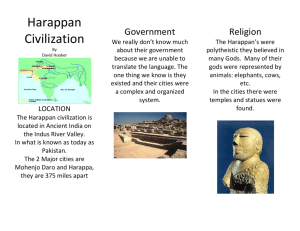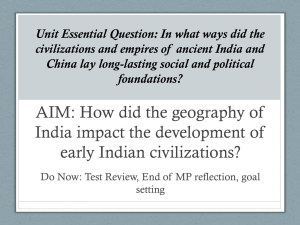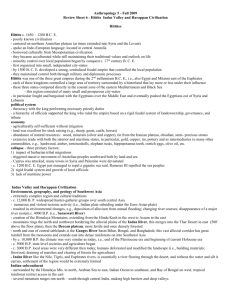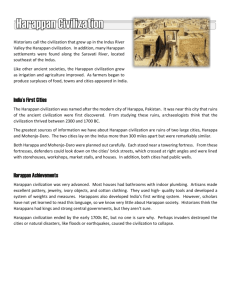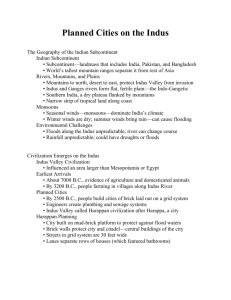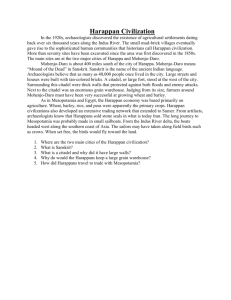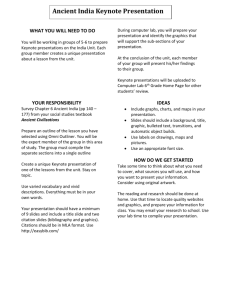Chapter 7: Ancient India
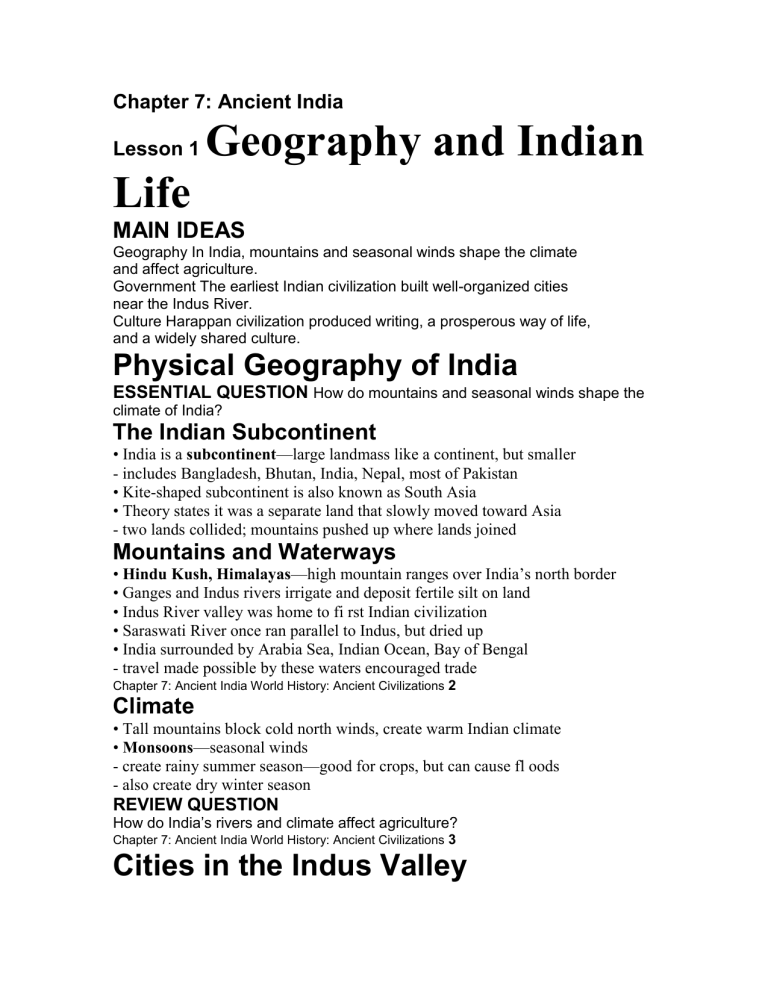
Chapter 7: Ancient India
Lesson 1
Geography and Indian
Life
MAIN IDEAS
Geography In India, mountains and seasonal winds shape the climate and affect agriculture.
Government The earliest Indian civilization built well-organized cities near the Indus River.
Culture Harappan civilization produced writing, a prosperous way of life, and a widely shared culture.
Physical Geography of India
ESSENTIAL QUESTION How do mountains and seasonal winds shape the climate of India?
The Indian Subcontinent
• India is a subcontinent
—large landmass like a continent, but smaller
- includes Bangladesh, Bhutan, India, Nepal, most of Pakistan
• Kite-shaped subcontinent is also known as South Asia
• Theory states it was a separate land that slowly moved toward Asia
- two lands collided; mountains pushed up where lands joined
Mountains and Waterways
•
Hindu Kush, Himalayas
—high mountain ranges over Indiaʼs north border
• Ganges and Indus rivers irrigate and deposit fertile silt on land
• Indus River valley was home to fi rst Indian civilization
• Saraswati River once ran parallel to Indus, but dried up
• India surrounded by Arabia Sea, Indian Ocean, Bay of Bengal
- travel made possible by these waters encouraged trade
Chapter 7: Ancient India World History: Ancient Civilizations 2
Climate
• Tall mountains block cold north winds, create warm Indian climate
•
Monsoons
—seasonal winds
- create rainy summer season—good for crops, but can cause fl oods
- also create dry winter season
REVIEW QUESTION
How do India’s rivers and climate affect agriculture?
Chapter 7: Ancient India World History: Ancient Civilizations 3
Cities in the Indus Valley
ESSENTIAL QUESTION Why was the earliest Indian civilization located near the Indus River?
Early Inhabitants
• Indus River valley civilization began with agriculture
- raised wheat, barley
- grew cotton and made fabric by 3000 B.C.
; fi rst Asians to do so
- domesticated cattle, sheep, goats, chickens
• Replaced stone tools with copper, bronze tools
• Trade created wealth, led to more complex culture
Great Cities
• Some villages grew into great cities by 2500
B.C.
- Indus, Saraswati valleys had hundreds of cities
• Largest cities, Mohenjo-Daro and Harappa, had 35,000 people each
• Ancient Indus Valley culture is called
Harappan civilization
•
Planned cities built by design with protective walls, street grids
- public buildings possibly used for religious, government functions
Dealing with Problems
• Harappan cities had sewers, houses with bathrooms and toilets
• Complex cities required planning, organization, powerful leaders
- Harappan government—structure unknown, but must have been strong
- may have had priests, kings, or combination of both
Harappan Culture
ESSENTIAL QUESTION What were the cultural features of Harappan civilization?
Harappan Writing
• Harappan writing remains mysterious, has never been translated
- had 500 pictographs—picture signs—for words or sounds or both
• Until writing is translated, must use artifacts to study Harappans
Harappan Religion
• No temples found for specifi c gods, but found evidence of religion
- Mohenjo-Daro public bath may have been used for cleansing rituals
- fi gurines of holy animals (bulls) and women (perhaps goddesses) found
A Widespread and Prosperous Culture
• Harappan culture spread across wide region
- cities with common design spread across 500,000 square-mile area
• People used standard weights and measures
• Trade wealth allowed luxuries like bronze statues, clay toys
• Traded timber, ivory, and beads with Mesopotamians
- received silver, tin, woolen cloth in return
Challenges to Harappan Life
• Earthquakes shook region around 2000 to 1500
B.C.
- possibly caused Saraswati River to dry up
- may also have caused Indus River to fl ood
• Disasters caused Harappan people to leave cities
- Harappan civilization declined
REVIEW QUESTION
How is the Harappan writing similar to hieroglyphs?
Chapter 7: Ancient India World History: Ancient Civilizations 5
Lesson Summary
• The rivers of India and the seasonal monsoons helped make agriculture possible.
• Agricultural wealth led to the rise of a complex civilization in the Indus Valley.
• The prosperous Harappan culture lasted for about 800 years.
Why It Matters Now . . .
Ancient Indians developed products that are still important today. They were the first people to domesticate chickens and the fi rst Asians to produce cotton cloth.
Lesson 2
The Origins of
Hinduism
MAIN IDEAS
Culture A group of nomadic people moved into India and took over what was left of Harappan civilization.
Government Under Aryan rule, Indian society developed a distinct system of social classes that still affects India today.
Belief Systems Over time, the belief of the Aryans developed into the religion of Hinduism.
Aryans Move Into India
ESSENTIAL QUESTION Who were the Aryans?
The Indo-European Migrations
• Hittites (who fought Egyptians) belonged to Indo-European group
- Indo-Europeans all spoke dialects of Indo-European language
• Most were nomads, lived in family clans, herded livestock
- warriors rode horse-driven chariots, used long bows, bronze axes
• Indo-Europeans fl ed homeland around 2000
B.C. for unknown reason
- Hittites went to Southwest Asia, many others settled in Europe
The Aryan Invasions
•
Aryans
—Indo-European herders who went east to India about 1500
B.C.
- lived in simple houses, spoke Indo-European language of Sanskrit
• Historians once thought Aryans drove Harappans from walled cities
- now believe that Harappan cities were in ruins before Aryans came
REVIEW QUESTION
Who were the Aryans, and where did they come from?
Chapter 7: Ancient India World History: Ancient Civilizations 2
Changes to Indian Life
ESSENTIAL QUESTION How was Aryan society organized?
The Caste System
• Aryans spread language, religion to Indiaʼs Dravidian people
• Aryanʼs warrior, priest, commoner classes grew into caste system
- caste
—social class whose members are identifi ed by their jobs
- thousands of caste groups organized into four categories
- untouchables—fi fth group later formed below others, did unwanted jobs
Aryan Beliefs and Brahmanism
• Early Aryan religion is called
Brahmanism today after Aryan priests
- worshiped nature gods, sacrifi ced animals to gods in sacred fi res
• Ceremonies became complex, lasting days or months
- rituals, hymns recorded in Sanskrit texts, called the Vedas
• Brahmanism changed in time to belief in one spirit governing the world
• Epic poem
Mahabharata and its Bhagavad Gita section retell legends
REVIEW QUESTION
What is the caste system?
Chapter 7: Ancient India World History: Ancient Civilizations 3
Hinduism: The Religion of India
ESSENTIAL QUESTION How did the religion of Hinduism develop?
Many Gods
•
Bhagavad Gita is most important text of Hinduism
- Hinduism
—major Indian religion that grew from early Brahmanism
• Hindus have many gods that are part of one supreme God, life force
• Most important gods include Brahma, the creator
- Vishnu, the protector
- Shiva, the destroyer—destroys world so it can be recreated
Many Lives
• Hindus believe in reincarnation
—each person has many lives
• Hindusʼ behavior in life determines what they will be in next life
• Reincarnation is determined by karma doctrine
- good deeds mean a person will be reborn as higher being
- evil deeds mean a person will be reborn as lower being, such as insect
• Hindus believe animals also have life force, so many are vegetarians
• Reincarnation creates cycle of birth, life, death, rebirth
- cycle ends when person realizes his or her soul is one with God
Many Paths to God
• Hindus connect to God by individual paths; path includes job
- Hindus carry out lifeʼs assigned duties as part of caste system
• Spiritual practices include meditation to calm mind, yoga
- the practice of yoga includes exercise, diet, breathing techniques


